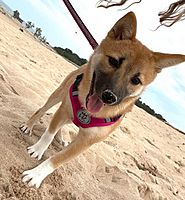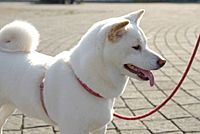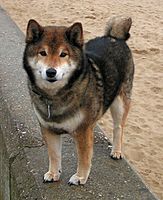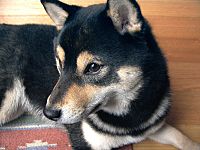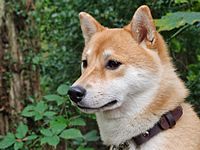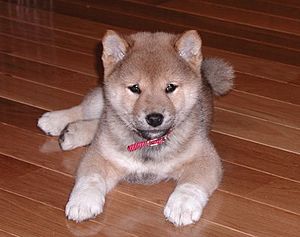Shiba Inu facts for kids
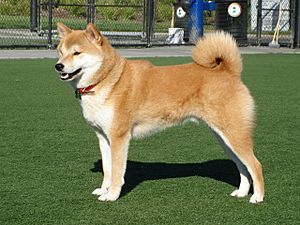
A three year old Red Shiba Inu
|
|||||||||||||||||||||||||||||||||
| Other names |
|
||||||||||||||||||||||||||||||||
|---|---|---|---|---|---|---|---|---|---|---|---|---|---|---|---|---|---|---|---|---|---|---|---|---|---|---|---|---|---|---|---|---|---|
| Origin | Japan | ||||||||||||||||||||||||||||||||
|
|||||||||||||||||||||||||||||||||
| Domestic dog (Canis lupus familiaris) | |||||||||||||||||||||||||||||||||
| Shiba Inu | |||||
|---|---|---|---|---|---|

"Shiba Inu" in kanji
|
|||||
| Japanese name | |||||
| Kanji | 柴犬 | ||||
| Hiragana | しば いぬ | ||||
|
|||||
The Shiba Inu is a special type of hunting dog from Japan. It's a small-to-medium sized dog. In fact, it's the smallest of the six original dog breeds that come from Japan. Its name means "brushwood dog" because it was used to help hunters find small animals hiding in bushes.
Shiba Inus are quick, smart, and good at moving around in mountains or on hiking trails. They were first bred to hunt. They might look a bit like other Japanese dogs, such as the Akita Inu. But the Shiba Inu is its own unique breed. It has a different family history, personality, and is smaller than those other Japanese dogs.
Contents
What Does a Shiba Inu Look Like?
A Shiba Inu has a strong, compact body with good muscles.
Their Fur and Colors
Shiba Inus have a double coat of fur. The outer layer is stiff and straight. The inner layer is soft and thick. The fur on their fox-like face, ears, and legs is short. The outer guard hairs stand out from their body. They are about 1.5 to 2 inches (3.8 to 5.1 cm) long at the shoulders. These guard hairs help protect their skin and keep out rain or snow. Their tail fur is a bit longer and looks like a brush. Their tails are a key feature that makes them special.
Some Shiba Inus have a cream-colored coat. This color is seen as a "major fault" by some dog clubs, like the Japan Kennel Club. This is because the special white markings, called "urajiro," are hard to see on cream fur. "Urajiro" means "underside white." However, the British Kennel Club says a white (cream) coat is perfectly fine.
The urajiro markings are a creamy white color. They are found on specific parts of the dog's body. These include the sides of the muzzle, cheeks, inside the ears, under the jaw, and on the upper throat. You'll also see them on the inside of their legs, on their belly, around their bottom, and on the underside of their tail. For red Shibas, urajiro is often on the throat and chest. For black and sesame colored Shibas, it often forms a triangle shape on both sides of the front chest.
Shiba Inu Personality
Shibas often like to be independent. The Japanese breed standard describes them as having a "spirited boldness." They are also "fiercely proud" and have a "good nature." They can move quickly with light, bouncy steps.
Cleanliness and Training
Shibas are very clean dogs. They like to keep themselves tidy. You might often see them licking their paws and legs, much like cats do. They usually try hard to keep their fur clean. Because they are so clean and proud, Shiba puppies are often easy to potty train. If their owner simply takes them outside after meals and naps, it's usually enough to teach them where to go to the bathroom.
Social Behavior
Shibas are not always friendly with other dogs if they haven't been trained well. Because of their independent nature, they might not be the best choice for people getting a dog for the very first time.
The "Shiba Scream"
A unique thing about this breed is something called the "shiba scream." If a Shiba Inu is very upset or bothered, it will make a loud, high-pitched scream. This can happen if someone tries to handle the dog in a way it doesn't like.
History of the Shiba Inu
The Shiba Inu is a very old dog breed. It existed long before many modern dog breeds appeared in the 1800s. Dogs that looked like Shiba Inus were even shown in ancient clay figures, called dogū, from Japan's prehistoric Jōmon period.
Shiba Inus were originally bred to hunt small animals like birds and rabbits. They lived in the mountains of the Chūbu region in Japan. Later, during a time called the Meiji Restoration, new dog breeds from other countries were brought to Japan. People started mixing these new breeds with native Japanese dogs. Because of this, by the early 1900s, there were almost no pure Shiba Inus left.
Around 1928, hunters and smart people became interested in saving the pure Shiba breed. They worked to protect the dogs that were left.
Saving the Breed
Even with these efforts, the Shiba Inu almost disappeared during World War II. This was because there wasn't enough food, and after the war, a disease called distemper spread. All the Shiba Inus we see today come from only three groups of dogs that survived. These groups were:
- The Shinshu Shiba from Nagano Prefecture. These dogs had a solid undercoat, thick guard hairs, and were small and red.
- The Mino Shiba from Gifu Prefecture. These often had thick, pointy ears and a tail that looked like a sickle, not the curled tail most Shibas have now.
- The San'in Shiba from Tottori and Shimane Prefectures. These were larger than most modern Shibas and were often black, without the common tan and white markings.
In the early to mid-1900s, experts studied Japanese dogs. They combined these three types into one breed, the Shiba Inu. The first official rules for the Shiba breed, called the Nippo Standard, were written in 1934. In 1936, the Shiba Inu was recognized as a Natural Monument of Japan. This was largely thanks to a group called Nippo, which works to preserve Japanese dogs.
Shiba Inus Around the World
The first Shiba Inu came to the United States in 1954 with a military family. The first recorded litter of Shiba puppies born in the U.S. was in 1979. The American Kennel Club officially recognized the Shiba in 1992. It was added to their Non-Sporting Group in 1993. Today, Shiba Inus are mostly kept as pets in Japan and other countries. The American Kennel Club says the Shiba Inu is the most popular companion dog in Japan. In the U.S., more and more people are getting Shiba Inus. In 2016, they were the 44th most popular breed, up from 50th in 2012.
Health and Care
Overall, the Shiba Inu is a healthy dog breed. Some health issues that can affect them include allergies, glaucoma (an eye condition), cataracts (cloudy eyes), hip dysplasia (a hip problem), entropion (eyelids turning inward), and luxating patella (a knee cap problem). It's a good idea for vets to check their joints regularly throughout their lives. Eye tests should be done every year because eye problems can develop over time. By the age of two, if a Shiba Inu hasn't shown any joint problems, they are usually considered free from them, as their bones are fully grown by then.
Like most dog breeds, Shibas need to be walked or exercised every day.
Life Span
Shiba Inus usually live for 12 to 15 years. Regular exercise, especially daily walks, helps them live a long and healthy life. The oldest known Shiba Inu, named Pusuke, lived to be 26 years old. He passed away in 2011. Pusuke was the oldest known dog alive at that time.
Grooming
Shiba Inus are very clean, so they don't need a lot of grooming. They naturally don't like to get wet or have baths. So, it's important to get them used to baths when they are young puppies. A Shiba Inu's fur is rough and short to medium length. The outer coat is about 1 to 1.25 inches (2.5 to 3.2 cm) long. It's naturally waterproof, so they don't need baths very often. They have a thick undercoat that keeps them warm even in very cold weather.
Shiba Inus shed their fur, especially when the seasons change, and a lot during the summer. Brushing them every day can help with this. It's important never to shave or cut a Shiba Inu's coat. Their coat is needed to protect them from both cold and hot temperatures.
See also
 In Spanish: Shiba Inu para niños
In Spanish: Shiba Inu para niños
- List of dog breeds
- Japan Kennel Club
- Mameshiba
- Nihon Ken Hozonkai
- Shiba Inu Puppy Cam


